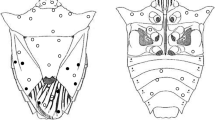Abstract
Erynniopsis antennata (Rondani), an introduced larval and larval-adult parasitoid of the elm leaf beetle (ELB),Xanthogaleruca luteola (Müller), was found in 11 of 12 northern California cities whereUlmus procera Salisbury andUlmus pumila L. were sampled in 1986 and/or 1987. Maximum apparent parasitism was over 40% in 4 of the cities, but mean parasitism for all sites combined was 4.5%. An introduced pupal parasitoid,Tetrastichus brevistigma Gahan, was found in only 7 cities, with mean and maximum apparent parasitism of 1.2 and 22%, respectively.E. antennata may be of value in managing ELB populations, but more knowledge of its biology and improved sampling methods are required.
Résumé
Erynniopsis antennata (Rondani), parasitoïde larvaire introduit de la galéruque de l'orme,Xanthogaleruca luteola (Müller), a été trouvé dans 11 des 12 villes de Californie du nord où des échantillonnages surUlmus procera Salisbury etUlmus pumilla L. ont été effectués en 1986 et/ou 1987. Le parasitisme apparent maximum fut supérieur à 40 % dans 4 des localités, mais le parasitisme moyen pour l'ensemble des sites fut de 4.5 %. Un parasitoïde des nymphes, également introduit,Tetrastichus brevistigma Gahan, a été trouvé dans 7 villes seulement, avec un taux de parasitisme apparent moyen et maximum de 1.2 et 22 % respectivement.E. antennata peut être utile pour la gestion des populations de galéruques de l'orme, mais une connaissance approfondie de sa biologie et de meilleures méthodes d'échantillonnage sont nécessaires.
Similar content being viewed by others
References
Azmayesh-Fard, P. &Esmaili, M. — 1981. An investigation on two species of elm leaf beetle parasitoids and their application for population density reduction of their host in Karadj. —J. Entomol. Soc. Iran, 6, 49–50.
Berry, P. A. — 1938.Tetrastichus brevistigma Gahan, a pupal parasite of the elm leaf beetle. —U. S. Dept. Agric. Cir., 485, 11 pp.
Burks, B. D. — 1979. Family Eulophidae. pp. 967–1022. In: Catalog of Hymenoptera in America North of Mexico. Vol. 1 (K. V. Krombein, P. D. Hurd, D. R. Smith, &B. D. Burks eds.). —Smithsonian Institute Press, Washington, D. C.
Clair, D. J. — 1986. Bionomics of the elm leaf beetle,Xanthogaleruca luteola (Müller), in northeastern California. —Ph. D. dissertation.Univ. Calif. Berkeley, 150 pp.
Clausen, C. P. — 1956. Biological control of insect pests in the continental United States. —U. S. Dept. Agric. Tech. Bull., 1139,pp. 66–68.
Dreistadt, S. H. — 1988. Ecology and management of the elm leaf beetle [Xanthogaleruca luteola (Müller)] [Coleoptera: Chrysomelidae] in northern California. —Ph. D. dissertation., Univ. Calif., Berkeley, 217 pp.
Dreistadt, S. H. & Dahlsten, D. L. — 1990. Relationships of temperature to elm leaf beetle [Coleoptera: Chrysomelidae] development and damage in the field. —J. Econ. Entomol. 83 (3), (in press).
Flanders, S. E. — 1940. Observations on the biology of the elm leaf beetle parasite,Erynnia nitida R.-Desv. —J. Econ. Entomol., 33, 947–948.
Kielbaso, J. J. &Kennedy, M. K. — 1983. Urban forestry and entomology: a current appraisal. pp. 423–440. In: Urban Entomology: Interdisciplinary Perspectives (G. W. Frankie &C. S. Koehler, eds.). —Praeger Publishers, New York.
Luck, R. F. &Scriven, G. T. — 1976. The elm leaf beetle,Pyrrhalta luteola, in southern California: its pattern of increase and its control by introduced parasites. —Environ. Entomol., 5, 409–416.
Olkowski, W., Daar, S., Green, M., Anderson, D. &Hyde, J. — 1986. Update: new IPM methods for elm leaf beetle. —IPM Practitioner, 8, (5), 1–7.
SAS Institute. — 1982. Statistical analysis system user's guide: statistics. —Cary, North Carolina, 584 pp.
Silvestri, F. — 1910. Contribuzioni alla conoscenza degli insetti dannosi e dei loro simbionti. —Boll. Lab. Zool. Gen. Agrar., 4, 246–289.
Svihra, P. — 1980. Dutch elm disease in California. —Div. Agric. Sci., Univ. Calif., Leaflet, 21189, 8 pp.
van Driesche, R. G. — 1983. Meaning of “percent parasitism” in studies of insect parasitoids. —Environ. Entomol., 12, 1611–1622.
Author information
Authors and Affiliations
Rights and permissions
About this article
Cite this article
Dreistadt, S.H., Dahlsten, D.L. Distribution and abundance ofErynniopsis antennata [Dipt.: Tachinidae] andTetrastichus brevistigma [Hym.: eulophidae], two introduced elm leaf beetle parasitoids in Northern California. Entomophaga 35, 527–536 (1990). https://doi.org/10.1007/BF02375087
Received:
Revised:
Issue Date:
DOI: https://doi.org/10.1007/BF02375087
Key-words
- insecta
- Xanthogaleruca luteola
- Erynniopsis antennata
- Tetrastichus brevistigma
- Tetrastichus erynniae
- biological control




